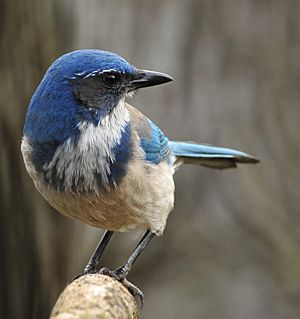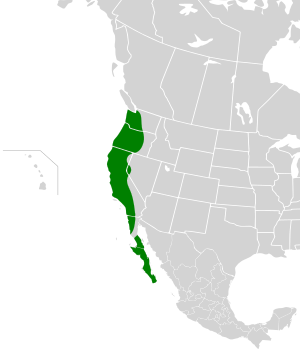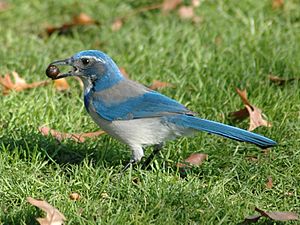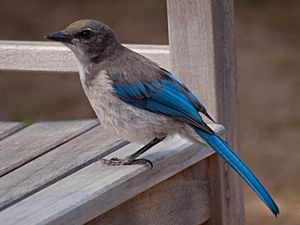California scrub jay facts for kids
Quick facts for kids California scrub jay |
|
|---|---|
 |
|
| California scrub jay in Seattle, Washington | |
| Conservation status | |
| Scientific classification | |
| Genus: |
Aphelocoma
|
| Species: |
californica
|
| Subspecies | |
|
See text |
|
 |
|
The California scrub jay (Aphelocoma californica) is a type of scrub jay bird. It lives in western North America. You can find it from southern British Columbia down through California and western Nevada.
This bird used to be grouped with other scrub jays, like the Woodhouse's scrub jay. They were all just called "western scrub jays." Later, scientists realized they were different species. California scrub jays do not migrate, meaning they stay in the same place all year. They can even live in cities and sometimes become friendly enough to visit bird feeders. Many people call them "blue jays," but the blue jay is actually a different bird species.
Contents
What's in a Name?
The name Aphelocoma comes from old Greek words. Apheles means "simple," and kome means "hair." This refers to how these jays don't have striped feathers like some other jays. The word californica simply means "from California."
What Does a California Scrub Jay Look Like?
The California scrub jay is a medium-sized bird. It is about 27 to 31 centimeters (11 to 12 inches) long, including its tail. Its wingspan is about 39 centimeters (15 inches), and it weighs around 80 grams (2.8 ounces).
These birds usually have a blue head, wings, and tail. Their back is gray-brown, and their belly is grayish. They have white eyebrows and a whitish throat with a blue "necklace" pattern. Their call is often described as a harsh, scratchy sound.
Where Do California Scrub Jays Live?
California scrub jays live in areas with low bushes and trees. They like pinon-juniper forests and oak woods. They also live at the edges of mixed evergreen forests. You can often spot them in suburban gardens too.
How Do They Find Food?
California scrub jays usually look for food in pairs or small family groups. They eat small animals like frogs and lizards. They also eat the eggs and young of other birds, and many kinds of insects. In winter, they especially enjoy grains, nuts, and berries. They might even eat fruits and vegetables from people's backyards. Sometimes, they can even be hand-fed by humans!

How Do They Store Food?
Like many other corvids (a family of birds that includes crows and jays), California scrub jays hide food. They store extra food in many small hiding spots around their territory. They have amazing memories to remember where they hid all their food, even after a long time. They can even plan ahead when choosing where to hide food. This helps them make sure they have enough food for later.
These jays are also known for stealing food from other jays' hiding spots. When they hide their own food, they often check to make sure no other jays are watching! They also like to hide and bury bright, colorful objects.
How Smart Are They?
Recent studies show that California scrub jays are very intelligent animals. Their brain size compared to their body size is similar to that of chimpanzees! They are also one of the few animals, besides humans and dolphins, that can plan for the future. This is called metacognition.
They can remember where they hid over 200 food caches. They also remember what kind of food is in each spot and how fast it might spoil. To protect their hidden food from other jays, they choose secret spots. Or, they might move their hidden food when they are alone. This suggests they can understand what others might be thinking.
California scrub jays also gather together and make loud calls when they find a dead jay. These "funerals" can last for up to 30 minutes!
Nesting and Raising Young
California scrub jay chicks start out completely gray. As they grow, they turn blue. Young chicks often have a red crest on their heads, like a small comb. This crest disappears after about seven days.
Nests are built low in trees or bushes, usually 1 to 10 meters (3 to 33 feet) above the ground. The female bird does most of the building, while the male guards her. The nests are strong, about 33 to 58 centimeters (13 to 23 inches) wide. They are made of twigs, moss, and dry grasses, and lined with soft roots and hair.
Females lay four to six eggs between March and July. The eggs can be pale green with olive spots, or grayish-white with reddish-brown spots. The female sits on the eggs for about 16 days. The young birds leave the nest about 18 days after they hatch.
How Long Do They Live?
In the wild, California scrub jays usually live for about 9 years. The oldest known western scrub jay lived in captivity and was almost 20 years old!
Health Concerns
The West Nile virus can affect California scrub jay populations. This is especially true in California's Central Valley.
Different Types of Scrub Jays
Scientists once thought that Woodhouse's, California, Island, and Florida scrub jays were all the same species. Now, they believe they are different.
California scrub jays are usually darker blue on top, with a clear blue band across their chest. Woodhouse's scrub jays are often paler blue and have a less clear breast band. There are also several different types of California scrub jays, called subspecies. These subspecies have slight differences in their size, color, and where they live.
Images for kids
See also
 In Spanish: Chara californiana para niños
In Spanish: Chara californiana para niños






